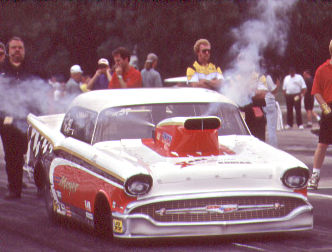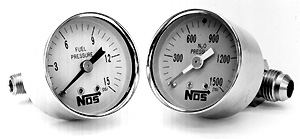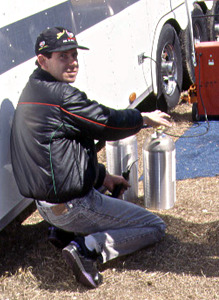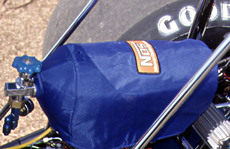The Zen of Purge, Part 2
 If you look up purge in the dictionary you find all kinds of examples,
most of which sound disgusting. Some refer to bloodily removing a
head of state from power or perhaps the transference of that strange
pizza to the porcelain round file. A more accurate description pertaining
to nitrous is to evacuate. We want to evacuate or get rid of some
unwanted air and gaseous nitrous and control the pressure at the same
time.
If you look up purge in the dictionary you find all kinds of examples,
most of which sound disgusting. Some refer to bloodily removing a
head of state from power or perhaps the transference of that strange
pizza to the porcelain round file. A more accurate description pertaining
to nitrous is to evacuate. We want to evacuate or get rid of some
unwanted air and gaseous nitrous and control the pressure at the same
time.
Unwanted? Sounds counterproductive to our goals of shoving as much
as we can cram down the engine’s throat without choking it. However,
purging does serve a couple of useful purposes.
Consistency is important in tuning a nitrous car. If you do not launch
at the same bottle pressure each time you will not be able to tell
what, if any, changes you need to make the next time. Nitrous pressure
is something you do have control over, at least at launch, so it is
in your best interest to dial it in.
GET THE AIR OUT
 When
you first turn the bottle on there will be an air lock between the
liquid nitrous and the solenoid. That is the primary function of purging.
You want to get rid of that airlock and have the right pressure in
relation to the fuel you are adding so the car will launch the same
each time. Without purging, the car will leave soft because the fuel
goes in first and the liquid nitrous has to play catchup. Of course
there may be a time or two that you may want it to happen this way
due to traction problems, but the bottom line in drag racing is to
put as much horsepower as possible to the ground as soon as you can.
When
you first turn the bottle on there will be an air lock between the
liquid nitrous and the solenoid. That is the primary function of purging.
You want to get rid of that airlock and have the right pressure in
relation to the fuel you are adding so the car will launch the same
each time. Without purging, the car will leave soft because the fuel
goes in first and the liquid nitrous has to play catchup. Of course
there may be a time or two that you may want it to happen this way
due to traction problems, but the bottom line in drag racing is to
put as much horsepower as possible to the ground as soon as you can.
BOTTLE PRESSURE DEPENDS ON TEMPERATURE
The second reason for primary purging is bottle pressure. Bottle pressure
is relative to temperature. When the nitrous is at about 85 degrees
it will be in the desired liquid state at a pressure of about 900
lbs. To give you an idea of how temperature is important to your tuning
techniques the following chart should show you the possibilities.
“Trick” launch pressures abound but we will use the most
commonly used number of 900 lbs for our discussion. 900 lbs matches
up to most of the manufacturers’ baseline settings. More important
is the fact that drag racing is done in (hopefully) nice weather and
85 degrees and 900 lbs just happens to match up nicely. Most of the
time anyway. Granted, you could run lower pressures and tune the fuel
jet accordingly, but it’s a bigger pain than trying to keep the
bottle pressure consistent. The best advice is to pick a number and
stick with it. Higher pressures are a problem however. Many of the
solenoids will not open above 1100 lbs so there is not much point
in taking that risk.
VOLUME KEEPS PRESSURE UP
The idea is to have the bottle pressure slightly higher than launch
pressure so you have a little room to purge down to your desired launch
pressure. Some bracket racers have this down to a minor science. They
try to keep the bottle at 925 to 950 and use only a short purge to
hit the 900 mark. Their thinking is not to waste any nitrous but the
real benefit of this approach is to keep as much volume in the bottle
as possible. This volume helps keep the pressure up longer as the
car goes down the track.
The biggest problem with bottle pressure is how to keep it at the
pressure point you desire. If it’s too high, a wet towel will
bring it down fairly quickly. I am assuming that it’s about 1000
lbs when I say that. If you just topped off the bottle and have extreme
1800 lbs of pressure, well, you have a problem. It’s going to
take a while, especially on a hot race day. Many racers keep an ice
chest handy just for this occasion.
WARMING THE BOTTLE
Warming up the bottle is a whole different can of worms. There are commercial
heaters available that attach to the bottle. These are thermostat controlled.
These are a love / hate deal. They work up to a point but suck up amps.
What some racers use is a 110 bolt heater and just use it in the pits.
They have their program down to the minute so they have a good idea
where the temp will be in the staging lanes and so on. There is a pressure
controlled heater available. It measures the pressure and turns the
heater on and off accordingly.
The downside as I see it is most bottles would have to be turned
open since the sensor is in the main line. This is not a good idea
since a leaking solenoid seal could lead to a hood launching condition.
If you choose this type of heater I recommend that you change your
bottle valve to one on the Super Hi Flow valves that have a port available
on the bottle side of the valve. This way the pressure can be controlled
without having the main line and solenoids exposed.
Another warming technique being used is what I call the bottle jacuzzi.
The bottles are submersed in a water container that uses a hot water
heating element and preferably a thermostat. The idea, and it works,
is to saturate both the bottle and the contents to a desired temperature.
My motorcycle customers are limited to a little 2 lb bottle and they
have found that if they start the “jacuzzi” process a day
in advance they have minimal pressure drop at the end of the quarter
mile. Food for thought.
DON’T DO THIS
 Warming techniques that you should never attempt? A propane torch.
Get real. I have seen highly intelligent individuals with backgrounds
in metal working doing this and I have to tell you I can’t go
the other way fast enough. Racing can sure make dolts out of Mensa
candidates. Torch warming is outlawed most places but somebody is
going to get killed by an exploding bottle due to this stupidity and
that will be the end of nitrous racing. Think about it. It doesn’t
take much to weaken aluminum and you are standing there with an open
flame? All it takes is an old valve O-ring, a flaw in the bottle or
soft point from the torch to create a bomb.
Warming techniques that you should never attempt? A propane torch.
Get real. I have seen highly intelligent individuals with backgrounds
in metal working doing this and I have to tell you I can’t go
the other way fast enough. Racing can sure make dolts out of Mensa
candidates. Torch warming is outlawed most places but somebody is
going to get killed by an exploding bottle due to this stupidity and
that will be the end of nitrous racing. Think about it. It doesn’t
take much to weaken aluminum and you are standing there with an open
flame? All it takes is an old valve O-ring, a flaw in the bottle or
soft point from the torch to create a bomb.
Case in point. I was tig welding on my dragster one evening about
a foot from the bottle. The shop was quiet and when I was done I heard
this little hiss. The heat from the welding had progressed through
the chassis and metal brackets to warm the bottle. Now I have to tell
you I was real surprised by that hiss. It turned out to be a flaw
in the bottom of the bottle. When it cooled to room temperature it
was fine. Subsequent testing showed that if the pressure exceeded
1000 lbs it would open up a leak. Moral of story. What would have
happened if an open flame had been used? No shop, no Dave, and a hopefully
interesting obituary!! Nuff said? I made a lamp out of the bottle,
by the way.
A BETTER WAY, BUTů
Hot air is probably a better way to hand warm the bottle. Maybe. I
have seen the exhaust from the tow truck used to warm the bottle.
BUT (you knew there was a “but” didn’t you?) you have
to stay with the bottle and monitor the pressure. Exhaust heat brings
the bottle up FAST.
A BAD EXAMPLE
This story was related to me by a customer. I don’t remember
the team involved and it does not matter but it should serve as an
example. The crew chief put the bottle inside the generator compartment
in his trailer and forgot about it. A while later there was a big
whooosh as the bottle pop-off blew. No big deal, except that the nitrous
being released in the compartment sent the generator rpm sky high.
Kaboom goes the generator as it kicked a rod out. Bad deal, yes, but
it’s not over yet. The kicked rod started a fire!! A big expensive
mess all around. So, just give some thought to what you are doing
when dealing with a pressurized container.
INSULATION
If you can find a way to insulate the bottle from its surroundings
it will be much easier to control the bottle pressure. Full bodied
race cars and street machines have the advantage of trunk space. Insulation
can be placed on the floor and the inside of the trunk lid to help
control bottle temperature over time. I did one street truck with
the bottle mounted in a gutted tool box in the bed. The original idea
was to hide the bottle, but I insulated the box to keep the pressure
under control. I went one step further and installed a purge valve
inside the box to cool it down on hot days if needed. It was needed.
A gauge in the cab was connected to the bottle to monitor the pressure.
A neat deal but way too much work. It worked very well.
PURGE AFTER A RUN
That little purge valve is handy for shutting down the system also.
When you are finished with the run, shut your bottle off and purge
off the nitrous left in the line. I know, I know, it’s wasteful-but
is it? Let’s say that it is 95 degrees out and it’s 3 hours
until your next pass. If you check the pressure you might find that
it’s really high. The reason is that in addition to the outside
temperature you also have heat coming off the pavement, off the headers
and engine, etc. Now what if the solenoid seeps a little bit and gets
nitrous in the engine? The next time you fire up the engine could
be exciting and expensive.
I think street machines need to pay attention to this even more.
The car sits out in the asphalt parking lot for 8 hours while you
work. Think hatch back microwave. You jump in the car and IF you don’t
have a leak (you did shut the bottle off last night?) you may have
a really lean condition due to the high pressure. Get a purge valve
and a gauge!! If the pressure is too extreme it will blow the solenoid
plunger and shut off the nitrous altogether. A lesser of two evils,
but still annoying.
If you do all the above and the pressure is extreme, do not turn
the bottle on. Take a wrench and crack the main feed line open a little
at the solenoid. Then open the bottle valve slowly till the pressure
drops to reasonable limits. Take care when doing this if your solenoid
and bottle are in the same vicinity because leaking nitrous will burn
you like RIGHT NOW. Been there.
DYNAMIC PURGING
Sometimes called the “bump” or the “burp,” this
is when you bring the engine rpm up to about 3500 and hit the nitrous
activation switch momentarily. The idea is to have both the fuel system
and the nitrous system purged at the same time. If you have a well
designed return style fuel system this is not necessary and static
purging the nitrous will take care of itself.
|
Dave Koehler has driven Junior fuel dragsters
in the 60s, Super-charged Top dragsters in the 70s, and Nitrous
powered cars in the 80s, in 1991 after two decades of running
a high performance engine / machine shop, he sold it in order
to spend more time doing R&D and manufacturing of specialty
Nitrous Oxide and Alcohol fuel injection systems and engine
balancing. He was also the onsite NOS tech rep at IHRA and NMCA
events from 1995-1997.
Contact Dave Koehler at:
Koehler Engineering
1888 CR 1400 N
Urbana, IL 61802.
phone (217) 469-7663
fax (217) 469-7910
www.koehlerinjection.com
|
Now I admit it, I have done this. Most nitrous racers have at one
time or another. I do not, however, believe it to be a good thing.
Any time you free rev an engine, with or without nitrous, you shorten
its life. The reason is that the components move so fast that the
oil system can’t keep up, so for a brief nano-second in time
there is the potential for the rod bearing to touch the crank without
the oil cushion. This “touch” increases the bearing clearances
and it just gets bigger and bigger as time goes on. No load means
that the pistons and rods are swinging out and jerking back in the
opposite direction. The load keeps a cushion effect that keeps things
under control. In the bad old days of stick shifts and no rev limiters
it was a given that if you missed a gear you must immediately change
the bearings. If you did not it was a sure bet you would be picking
the rods off the ground within the next 5-6 laps. Its up to you.
To be an effective nitrous tuner you must get as many things under
control as possible in order to be fast and consistent. Purging the
bottle is just one of those tools. Take control. The good news is
that its not an expensive project compared to all the stuff you already
purchased.

 If you look up purge in the dictionary you find all kinds of examples,
most of which sound disgusting. Some refer to bloodily removing a
head of state from power or perhaps the transference of that strange
pizza to the porcelain round file. A more accurate description pertaining
to nitrous is to evacuate. We want to evacuate or get rid of some
unwanted air and gaseous nitrous and control the pressure at the same
time.
If you look up purge in the dictionary you find all kinds of examples,
most of which sound disgusting. Some refer to bloodily removing a
head of state from power or perhaps the transference of that strange
pizza to the porcelain round file. A more accurate description pertaining
to nitrous is to evacuate. We want to evacuate or get rid of some
unwanted air and gaseous nitrous and control the pressure at the same
time. When
you first turn the bottle on there will be an air lock between the
liquid nitrous and the solenoid. That is the primary function of purging.
You want to get rid of that airlock and have the right pressure in
relation to the fuel you are adding so the car will launch the same
each time. Without purging, the car will leave soft because the fuel
goes in first and the liquid nitrous has to play catchup. Of course
there may be a time or two that you may want it to happen this way
due to traction problems, but the bottom line in drag racing is to
put as much horsepower as possible to the ground as soon as you can.
When
you first turn the bottle on there will be an air lock between the
liquid nitrous and the solenoid. That is the primary function of purging.
You want to get rid of that airlock and have the right pressure in
relation to the fuel you are adding so the car will launch the same
each time. Without purging, the car will leave soft because the fuel
goes in first and the liquid nitrous has to play catchup. Of course
there may be a time or two that you may want it to happen this way
due to traction problems, but the bottom line in drag racing is to
put as much horsepower as possible to the ground as soon as you can.


 Warming techniques that you should never attempt? A propane torch.
Get real. I have seen highly intelligent individuals with backgrounds
in metal working doing this and I have to tell you I can’t go
the other way fast enough. Racing can sure make dolts out of Mensa
candidates. Torch warming is outlawed most places but somebody is
going to get killed by an exploding bottle due to this stupidity and
that will be the end of nitrous racing. Think about it. It doesn’t
take much to weaken aluminum and you are standing there with an open
flame? All it takes is an old valve O-ring, a flaw in the bottle or
soft point from the torch to create a bomb.
Warming techniques that you should never attempt? A propane torch.
Get real. I have seen highly intelligent individuals with backgrounds
in metal working doing this and I have to tell you I can’t go
the other way fast enough. Racing can sure make dolts out of Mensa
candidates. Torch warming is outlawed most places but somebody is
going to get killed by an exploding bottle due to this stupidity and
that will be the end of nitrous racing. Think about it. It doesn’t
take much to weaken aluminum and you are standing there with an open
flame? All it takes is an old valve O-ring, a flaw in the bottle or
soft point from the torch to create a bomb.